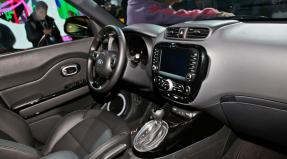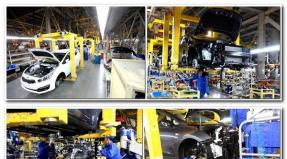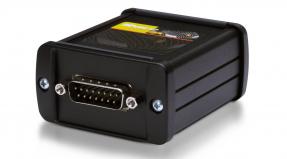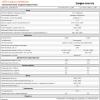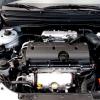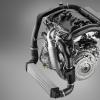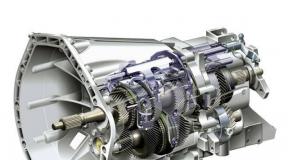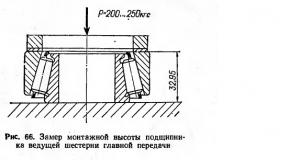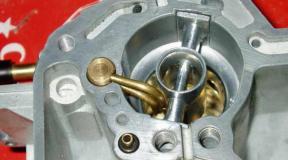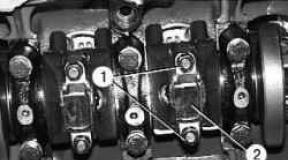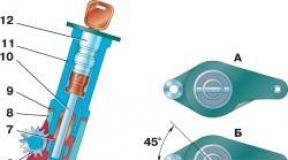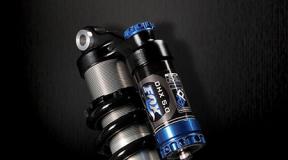Dsg 6 what kind of oil. How to change the oil in the DSG box
The manufacturer himself claims that the DSG robot is highly reliable and is a profitable solution compared to traditional hydromechanical automatic transmissions or CVTs. One way or another, it is important to understand that this box needs regular and high-quality maintenance, taking into account a number of features of its design.
Such maintenance should be understood, first of all, to change the oil in the DSG, as well as the DSG. Next, we will talk about when the oil in the DSG needs to be changed, how the oil is changed in DSG box, as well as what to look for during this procedure.
Read in this article
Changing gear oil in a DSG robot: when is it needed and why

So, the specified checkpoint is based on mechanical box, as well as (by analogy with the manual transmission). In other words, unlike "classic" automatic machines or a variator, there is no torque converter.
At the same time, there are two clutch discs, due to which the gears change very quickly and smoothly. The result is a high level of comfort and fuel efficiency, as well as impressive acceleration dynamics, since there is practically no break in the power flow at the moments of switching, etc.
It controls the operation of the gearbox and clutch, as well as (analog). In fact, the electronic unit sends signals to the actuators, after which, due to the redistribution of fluid (oil) flows in mechatronics, gears are switched on and other processes are controlled.
It is quite obvious that the presence of such a device as a mechatronic means increased requirements for quality and condition. transmission oil... In other words, a timely oil change in the DSG box is required.
Immediately, we note that, according to the regulations, an oil change in DSG-6, and also often in DSG-7, is required every 60 thousand km. However, if the car is operated in difficult conditions (towing a trailer, aggressive driving, maximum loads), it is necessary to change the transmission oil earlier (the interval is reduced by 20-30 or even 40%).
Please note, DSG-6 is and can go about 200-250 thousand km. without repair. It is important to understand that the result untimely replacement oil in the box simultaneously with the violation of the operating requirements for the gearbox is the overwhelming majority of DSG failures encountered.
Also, after changing the oil, most owners note that after replacing, for example, in the DSG-6, shocks disappear when switching, the gearbox works smoothly, without jerking. Next, we will look at the process of changing the oil in the DSG-6 with our own hands.
How to select and change oil in DSG

So, in order to change the oil in the DSG, it is necessary to select in advance a special transmission fluid or oil in the DSG box, which is suitable for units of this type. To change the oil in a DSG box, for example, DQ-250, you will need 6 liters of gear oil.
Considering that such a gearbox with a "wet" clutch (clutch packs are immersed in an oil bath), more oil is needed in this case. As for the DSG-7 with the so-called "dry" clutch, such a box requires less transmission fluid.
We also note that in addition to the liquid, it is necessary to change the oil filter of the DSG box, as well as a special sealing ring of the drain plug. As a rule, when replacing, original oils and transmission fluids with VW TL52182 approvals are used. You can also select suitable third-party counterparts.
The main thing is to use high quality products as well. If we talk about the replacement itself, you can either use the services of specialized service stations, or perform all the manipulations yourself.
- First of all, in addition to the oil and the gearbox filter, you will need a garage with a viewing hole or lift, a set of tools, containers for draining mining, rags;
- Before starting the replacement, the box must be warmed up by driving a car for about 10 km;
- Next, the machine is placed on a pit or lifted on a lift, if available, the engine protection is removed;
- Then you will need to remove the air intake along with the air filter, battery with a casing and a pan;
- Next, the plastic cup is unscrewed, the filter is removed;
- Then you need to remove the breather cap (located closer to the headlamp from the filter);
- Now you can go down under the car and unscrew drain plug, substitute a container where the mining will be merged;
- After unscrewing the plug, a hex key is inserted into the hole, with which a special insert is unscrewed. This allows the maximum amount of oil to be drained;
- After removing the insert, you need to wait until all the oil is drained into the container;
- At the same time, you need to soak the new filter of the DSG box with fresh oil. To do this, you can insert the filter into the cup case and spill it with oil;
- After the oil has completely drained from the gearbox, the insert can be tightened, but the drain plug does not need to be tightened. If you tighten it, the oil will be poured into the unit faster;
- To avoid oil leaks, place a container in the area of the drain hole.
- Now it remains to insert the funnel into the gearbox breather (from above under the hood) and fill in fresh oil. Pour in slowly and carefully, dosing portions.
We also add that oil can be filled in in other ways (for example, pumped in with a syringe through the drain hole), but in practice, filling through the breather is the fastest and most efficient. Also, after about 4.5 liters of oil has been poured into the box, you need to tighten the gearbox oil filter cover, replace the breather cap, install the previously removed elements of the engine intake system, connect the terminals to the battery.
At the same time, you do not need to tighten or twist anything yet. At the same time, the old gearbox drain plug is installed (we do not install a new one yet, the O-rings do not change either). Next, the engine must be started by connecting in parallel to the ECU through.
The main task is to wait until the oil in the DSG warms up to 40-48 degrees. After such heating, the engine does not need to be turned off, while the old drain plug should be unscrewed. It is important that the oil drips a little from the hole as a result of vibrations from a running internal combustion engine.
Then you need to wait some time until the excess flows out, that is, the required amount remains in the gearbox (the plug-in plug installed in the drain hole will not allow more grease to flow out). Please note that if the oil does not immediately drip when unscrewing the plug, this indicates that it is not filled in enough and needs to be refilled.
After the oil stops dripping, this will indicate the correct oil level in the gearbox. In this case, you can tighten the already new plug with an O-ring, and also turn off the engine. Now you can start reassembling by tightening all previously removed and unscrewed elements. This completes the oil change.
What is the bottom line
As you can see, although the DSG gearbox is not a "classic" automatic and is more like a manual transmission, the oil change in the DSG should be done more often and regularly.
The reason is the presence of mechatronics and increased sensitivity to transmission fluid in the gearbox. The manufacturer's own regulations also indicate the need for replacement, that is, such a box cannot be considered officially maintenance-free.
It turns out that the owners of car models with DSG-6 should take into account that the service life of the transmission directly depends on the timely replacement of the oil and the gearbox filter in the transmission. You also need to follow certain operating rules (avoid abrupt starts, high loads, slippage, towing a trailer and other cars).
Finally, we note that changing the oil in the DSG-6 or DSG-7 box in some cases allows you to improve the quality of the gearbox itself, get rid of jerks when shifting, the car accelerates better, the transmission makes less noise during operation, vibrates less so much, etc. P.
Read also
How to use the box DSG transmission and save the resource, as well as increase the service life. Features of the operation of a robotic gearbox with two clutches.
1. Disconnect the connector from the Mass Air Flow Sensor and by squeezing the spring clip, disconnect the air pipe from the air filter housing. 
2. We disassemble the air intake to disconnect the air pipe. 

3. Unscrew the bolt securing the air filter housing. 

4. Then pull off the air filter housing from the rubber mounts. 

5. Remove the battery cover and remove the front casing. 
6. Remove the terminals from the battery, unscrew the mount and remove the battery. 
7. Unscrew the three bolts securing the battery pad and remove it. 

8. Unscrew the oil filter housing and remove. 



9. We remove the gearbox oil filter. 
10. We pump out the remains of the old oil from the honeycomb in the gearbox housing. 

11. Remove the crankcase protection. 

12. Unscrew the drain plug with a 14 mm hexagon. and drain the oil. Approximately 0.8 liters will drain. oils. 



13. When the trickle becomes thin, then insert the 8 mm hexagon. into the drain hole and unscrew the overflow glass. Approximately 4.4 liters will drain. oils. 



14. As the oil has drained, screw the overflow cup back into the drain hole. 

15. We tighten the drain plug with the old O-ring. 

16. Insert the filling hose into the hole in the oil filter. 

17. We begin to fill in oil. Fill 5.4 liters of oil (with a small margin) into DSG6.
The total filling volume of oil on the PBZ gearboxes is 7.2 liters, and the service volume (which is replaceable) is 5.2 liters. oils. Therefore, we fill in a little more oil in order to then set the oil level correctly. It is equally bad for the DSG box if the oil is overflowed or not topped up.
18. Comparison of KP filters. 
19. When finished pouring oil into the box, remove the filling hose and set it aside. 

20. Install a new oil filter. Having previously lubricated the lip seal with gear oil. Attention! The filter must be placed on the stem into which we poured oil. Be sure to twist it to the left - to the right to prevent the filter lip seal from wrapping..

21. My oil filter housing from oil. 

22. Change the O-ring on the oil filter housing. 

23. Install the oil filter housing and tighten it to 20 Nm. 

24. Install the battery pad back into place. 
25. Install the battery and connect the terminals. 
26. Install the front casing and battery cover. 
27. Install the air filter housing on the rubber mounts. 
28. We tighten the air filter mounting bolt. 

29. Install the air intake. 
30. Connect the air inlet to the air filter housing and connect the Mass Air Flow Sensor connector. 

31. We connect the diagnostic device. Go to "Measured values" and open group 19. Group 19.2 displays the current oil temperature in gearbox 02E.
33. We start the engine and switch the selector, lingering for 3-5 seconds for each gear. Then return the lever to the "P" position. To set the level, the oil in the gearbox must be warmed up in the range from 35-45 degrees. 
Below is a photo showing the principle of operation of an overflow glass in a DSG 6 box. 
34. Heating the oil to a certain temperature, we unscrew the drain plug and drain the excess oil (200 grams that we poured over).


35. While the excess oil is being drained, change the O-ring on the drain plug to a new one. 

36. Drain the oil until the trickle of oil becomes thin. We have merged about 200 grams of oil, now the level is set in accordance with the regulations. We immediately tighten the drain plug and tighten it to 45 Nm. 

37. We wash the gearbox housing from traces of oil. 

38. Install the crankcase protection. 

Fill nuances:
Fill the oil in the box, according to the regulations, through the drain plug, i.e. from the bottom of the car. This is due to the fact that the filter in some cases does not change (again, according to the regulations, photo at the beginning). But when a simultaneous replacement is made, it is more convenient to do this from under the hood, into the filter hole.
When changing the oil in the DSG 6 box, the car must be parked on a flat surface.
It's good when the car is new and you don't need to think about where and when to service your iron horse. Another thing is when you bought a used car that has expired the warranty, it is clear that there is no point in continuing to service the car from an authorized dealer. In today's article, we will talk in detail about how to independently change the oil in the DSG-7 box in Volkswagen passat CC (there is practically no difference between replacement in the restyled and derestyled versions, at least the process itself is completely similar). Also consider the issue of choosing an oil, which oil is recommended by an authorized dealer and which oil is best suited as an analogue so that you can save a little.
Owners of used Volkswagen Passat SS 1.8 with DSG-7 often have a question whether they need to change the oil in the box or not? Disputes arise due to the fact that the DSG-7 uses a dry clutch, hence many people mistakenly think that there is no oil in the box and therefore there is nothing to change there. Let's hasten to dispel this myth.
How much oil is in the DSG-7 DQ 200 box?
The second most popular question, which logically follows from the first, is how much oil is needed for replacement? Having studied a huge number of forums where owners share their experience, we came to a figure of 2.1 liters. For comparison, the oil change in DSG-6 is 6 liters, it is easy to remember the number of exactly the number of gears.
What kind of oil to fill?
It is best to pour the manufacturer's recommended gear oil G 052 512 A2.It is sold in liter bottles at the price  from 900 to 1,300 rubles, depending on the region. This product is suitable for mechanical and robotic transmissions (DSG-7 DQ 200) installed in Audi, Skoda, SEAT and Volkswagen.
from 900 to 1,300 rubles, depending on the region. This product is suitable for mechanical and robotic transmissions (DSG-7 DQ 200) installed in Audi, Skoda, SEAT and Volkswagen.
Alternatively, some use:
- FEBI 21829 price from 500 rubles per 1 liter;
- SWAG 10921829 price from 500 rubles per 1 liter;
- VAG GCN052512Z2 price from 900 rubles per 1 liter.
Step-by-step instructions for changing the oil yourself
Before proceeding to the description of the actions, in addition to oil, you will need a drain plug; its cost is 170 rubles. From the tools you will need a “10” hexagon, a syringe with a flexible hose and the actual container where the old oil will be drained. This process should take place on a warm transmission. so let's get started:
- remove the plastic protection;
- unscrew the gearbox plug;
- drain the oil;
- we twist the cork;
- we put plastic protection;
- remove the breather cap;
- insert the tube into the hole;
- fill in oil (Important! you need to fill in oil exactly as much as the old one poured out, because the box is not equipped with a dipstick, calculations will have to be done independently);
- put the breather cap in place.
That is, in principle, the whole process, which should not cause any particular difficulties and for a long time. By the way,
SEAT Leon Copa Plus car. Bundle 1.8TSI + DSG7 + ABS + ESP + EBD.
Robotic transmission DSG-7, DQ200, 0AM, NTQ... We purchase original VAG transmission oil, order code - G052512A2... The gearbox drain plug is unscrewed with a regular hexagon by 10.
Photo-1: DSG-7 in section.
If you could damage, then the plug code - N10037105. Both items are taken from the catalog by VIN-number.
We spied on how to change the oil from Alexander Willwillis from Drive2.ru. He has everything clearly told and shown. A couple of additions from us. If you have never removed the air filter housing, then check in advance how it is done. At 1.8 TSI, to remove it, you need to carefully pull up, because it sits tightly on two landing pins of the battery platform, and rubber dampers are located in the filter housing mounting holes. And one moment. We drained 1.7 liters of used oil from the DSG7 box, and filled in all 2 liters.
The oil change in DSG-7 was carried out at a mileage of 76,000 km. What made us do this? Doubts! Doubts that in the constantly contacting parts of the gearbox, the technical fluid can work out the entire life of the car and retain its performance characteristics... 2 years of warranty - yes, the gear oil is capable of working. So what is next? And if the car is used for 5-7 years? We think not. The gearbox oil is not able to work without losing its physical and chemical characteristics for such a long period. Therefore, they made a replacement. The result is below.
 |
Photo-2: metal particles in waste oil from DSG7. Mileage 76 thousand km. |  |
Photo-3: again metal particles in waste oil from DSG7. |
 |
Photo-4: used oil color from DSG. The bottle stands in front of the sun's rays and does not shine through. Photo taken without flash. |  |
Photo-5: comparison of fresh and used DSG7 oil by color. Photo taken with flash. |
 |
Photo-6:comparison of fresh and used DSG7 oil by color. Photo taken without flash |
Subjectively, we did not do the oil change procedure in vain. The box began to switch very gently, barely noticeable.
19.07.2016 After changing the oil in the gearbox, 4 months have passed and 6,000 km have been driven. During this time, no problems arose: there were no smudges, fogging due to the filling of 2 liters of oil, and there are no. The car was accelerated 1 time to 200 km. at one o'clock.
Our conclusion: the oil in the mechanical part of the DSG-7 needs to be changed. How often? We believe that every 60 thousand km.
Since the invention of the car, designers have constantly tried to improve and automate the gearbox. Some automakers offered their own automatic transmission options. So, the German concern Volkswagen has developed and brought to the market a robotic gearbox DSG.
Features of the device and operation of the DSG box
DSG (Direct Shift Gearbox) literally translates as a gearbox with direct shift and in the strict sense of the word is not considered an automatic. It would be more correct to call it a preselective dual-clutch transmission or a robot. Such a box consists of the same elements as a mechanical one, but the functions of gear shifting and clutch control are transferred to the electronics. From the driver's point of view, the DSG box is automatic with the ability to switch to manual mode. In the latter case, the gear change is performed with a special steering column switch or the same gearbox lever.
For the first time, the DSG box appeared on Porsche racing cars in the 80s of the last century. The debut turned out to be successful - it surpassed the traditional mechanics in terms of gear change speed. The main disadvantages, such as high cost and unreliability, were overcome over time, and DSG boxes began to be massively installed on serial cars.
The main popularizer of robotic gearboxes was Volkswagen, having installed such a gearbox on VW Golf 4 in 2003. The first variant of the robot is called DSG-6 in terms of the number of gear stages.
Device and characteristics of the DSG-6 box
The main difference between a DSG box and a mechanical box is the presence of a special unit (mechatronics) that performs the function of shifting gears for the driver.
Mechatronics consists of:
- electronic control unit;
- electro-hydraulic mechanism.
The electronic unit reads and processes information from the sensors and issues commands to the executive mechanism, which is the electrohydraulics unit.
A special oil is used as a hydraulic fluid, the volume of which in a box reaches 7 liters. The same oil is used to lubricate and cool clutches, gears, shafts, bearings and synchronizers. During operation, the oil heats up to a temperature of 135 ° C, therefore, a cooling radiator is integrated into the DSG oil circuit.
The hydraulic mechanism with the help of electromagnetic valves and hydraulic cylinders sets in motion the elements of the mechanical part of the gearbox. The DSG mechanical circuit is implemented using double clutch and two gear shafts.
The double clutch is technically implemented as a single unit of two multi-plate clutches. The outer clutch is connected to the input shaft of the odd gears, and the inner one is connected to the input shaft of the even gears. The input shafts are installed coaxially, with one partly located inside the other.
The dual-mass flywheel transmits engine torque to the clutch, which is connected to the gear corresponding to the current crankshaft speed. In this case, the mechatronic immediately selects the next gear on the second clutch. Having received information from the sensors, the electronic control unit decides to switch to another gear. At this point, the second clutch closes on the dual-mass flywheel and instantaneous gear changes take place.
The main advantage of a DSG gearbox over a hydromechanical automatic transmission is considered to be the gearshift speed. This allows the vehicle to accelerate even faster than in use. manual transmission... At the same time, fuel consumption is reduced due to the selection of the correct transmission modes by the electronics. According to the representatives of the concern, the fuel economy reaches 10%.
Features of the DSG-7 box
During the operation of the DSG-6, it was found that it is not suitable for engines with a torque of less than 250 Nm. The use of such a box with weak engines led to a loss of power when shifting gears and an increase in fuel consumption. Therefore, since 2007 of the year Volkswagen began to install a seven-speed gearbox version on budget cars.
The principle of operation of the new version of the DSG box has not changed. Its main difference from the DSG-6 is the dry clutch. As a result, the oil in the box became three times less, which, in turn, led to a decrease in its weight and dimensions. If the weight of the DSG-6 is 93 kg, then the DSG-7 already weighs 77 kg.
In addition to the DSG-7 with a dry clutch, for engines whose torque exceeds 350 Nm, Volkswagen has developed a version of a seven-speed gearbox with an oil circuit. Such a box is used on cars of the VW Transporter and VW Tiguan 2 families.
Diagnostics of faults of the DSG box
The novelty of the design is the main reason for the appearance of problems in the operation of the DSG box. Experts identify the following signs of its malfunctions:
- jerks when moving;
- transition to emergency mode (the indicator lights up on the display, you can continue driving only in one or two gears);
- extraneous noise in the area of the gearbox;
- sudden blocking of the box lever;
- oil leak from the box.
The same symptoms can indicate different problems. So, jerking while driving can be caused by malfunctions of both the mechatronics and the clutch. The emergency mode indication does not always lead to restrictions in the gearbox operation. Sometimes it disappears after restarting the engine or disconnecting the battery. However, this does not mean that the problem has disappeared. Blocking of the selector lever can be caused by freezing of the drive cable, any mechanical damage or breakage.
The most problematic elements of a DSG box are:
- mechatronic;
- dual-mass flywheel;
- multi-plate clutch;
- bearings of the shafts of the mechanical part.
In any case, if you suspect a DSG gearbox malfunction, you should immediately contact a Volkswagen service center.
DSG Box Self Service
There is no consensus on the issue of the possibility of self-service and repair of the DSG box to date. Some car owners believe that when problems arise, it is necessary to change the assemblies. Others try to disassemble the box and fix the problem with their own hands. This behavior is due to the high cost of DSG box repair services. Moreover, experts often attribute the malfunctions to the design features and try to avoid work, especially if the car is under warranty.
Self-elimination of faults in the DSG box requires high qualifications and the availability of computer diagnostics tools. The large weight of the unit requires the participation of at least two people and strict adherence to safety precautions.
As an example of a relatively simple DSG repair, consider a step-by-step mechatronics replacement algorithm.
Replacing the mechatronics DSG box
Before replacing the mechatronics, it is necessary to move the rods to the dismantling position. This procedure will greatly facilitate the dismantling process in the future. This can be done using the Delphi DS150E diagnostic scanner.
To work, you will need the following tools:
- a set of torexes;
- set of hexagons;
- tool for fixing clutch blades;
- set of open-end wrenches.
Dismantling of mechatronics is carried out in the following order:
- Place the car on a lift (overpass, pit).
- Remove engine cover.
- In the engine compartment, remove the battery, air filter, necessary pipes and harnesses.
- Drain transmission oil.
- Disconnect the connector holder.
- Unscrew the mechatronics fixing screws.
- Take the clutch block away from the box.
- Disconnect the connector from the mechatronics board.
- Pull gently towards you and remove the mechatronics.
The installation of the new mechatronics is carried out in the reverse order.
Self-change of oil in the DSG box
DSG-6 and DSG-7 boxes need regular oil changes. However, for DSG-7, the manufacturer does not provide for this procedure - this unit is considered maintenance-free. Nevertheless, experts recommend changing the oil at least every 60 thousand kilometers.
You can change the oil yourself. This will save up to 20-30% in maintenance costs. It is most convenient to perform the procedure on a lift or a viewing pit (overpass).
The procedure for changing the oil in the DSG-7 box
To change the oil in the DSG-7 box, you will need:
- internal hex key 10;
- funnel for filling oil;
- syringe with a hose at the end;
- container for draining used oil;
- drain plug;
- two liters of gear oil complying with standard 052 529 A2.
The heated oil will drain faster from the gearbox. Therefore, before starting work, the transmission should be warmed up (the easiest way is to make a short trip). Then you should free up access to the top of the box in the engine compartment. Depending on the model, it will be necessary to dismantle the battery, air filter and a number of pipes and wires.
To change the oil in the DSG-7 box, you must:
The procedure for changing the oil in the DSG-6 box
About 6 liters of transmission fluid are poured into the DSG-6 box. Oil change is carried out in the following sequence:
- Position the vehicle on a lift, overpass or inspection pit.
- Remove engine cover.
- Place a container under the drain plug to drain the used oil.
- Unscrew the drain plug and drain the first part (about 1 liter) of oil.
- Unscrew the test tube from the drain hole and drain the main part of the oil (about 5 liters).
- Screw in a new drain plug.
- To access the upper part of the transmission, remove the battery, air filter, necessary harnesses and pipes.
- Remove the oil filter.
- Fill in 6 liters of gear oil through the filler neck.
- Install a new oil filter and screw on the cap.
- Start the engine and let it run for 3-5 minutes. At this time, switch the gearbox lever to each position for 3-5 seconds.
- Unscrew the drain plug and check for an oil leak from the drain hole.
- If there is no oil leakage from the drain hole, continue filling.
- If an oil leak occurs, screw the drain plug and install the engine guard.
- Start the engine, make sure there are no errors on the dashboard.
- Test drive and make sure the transmission is working properly.
Reviews of motorists about DSG boxes
Since the appearance of the DSG box, its design has been constantly improved. However, robotic boxes are still quite capricious units. The Volkswagen concern periodically carries out a massive recall of vehicles with DSG transmissions. The manufacturer's warranty for boxes is now increased to 5 years, then reduced again. All this testifies to the incomplete confidence of the manufacturer in the reliability of DSG boxes. Negative reviews from owners of cars with problematic boxes also add fuel to the fire.
Review: Volkswagen Golf 6 - hatchback - Not bad car, but DSG-7 requires constant attention
Pluses: Frisky engine, good sound and insulation, comfortable interior. Disadvantages: Unreliable automatic transmission. Had the honor of owning this car in 2010, 1.6 engine, DSG-7 gearbox. Pleasantly pleased with the consumption ... In the mixed mode, the city-highway was 7l / 100km. I was also pleased with the sound insulation and the quality of the regular sound. Good throttle response both in the city and on the highway. The box, if necessary, does not slow down fast overtaking. But at the same time, the main problems are in the same box !!! With a mileage of 80,000 km. the box began to twitch when switching from 1 to 2 in traffic jams ... As many have already said, this is a flaw in this box, as well as in the previous DSG-6 ... I am still lucky, many have problems much earlier ... So, ladies and gentlemen, when buying this brand auto pay attention to this moment !!! And always on a hot engine !!! Since it appears only when the box is warmed up !!! Usage time: 8 months Year of car production: 2010 Engine type: Gasoline injection Engine displacement: 1600 cm³ Transmission: automatic Drive type: Front ground clearance: 160 mm Airbags: at least 4 Overall impression: The car is not bad, but DSG-7 requires constant attention! More details on Otzovik: http://otzovik.com/review_2536376.html
oleg13 Russia, Krasnodar
http://otzovik.com/review_2536376.html
Review: Volkswagen Passat B7 sedan car - Does not live up to expectations about German quality
Pluses: Comfortable. It accelerates quickly due to the turbine. Sufficiently economical in fuel consumption
Disadvantages: No quality, very expensive repairs
It so happened that since 2012, our family has received a VW Passat B7 car. Automatic transmission (dsg 7), the most complete set. So! The car made the first impression, of course, and it was very good, since there were no foreign cars of this class in the family yet. But the impression was short-lived. The first step was to compare the complete set of the car with other automakers. For example, the Camry's driver's seat is electrically adjustable, but here you have to do everything with your hands. Further about the quality of the salon. The plastic is awful and ugly compared to the French or the Japanese. The leather on the steering wheel is rubbed off very quickly. The leather of the front seats (since they are used more often) also cracks very quickly. The radio tape recorder often freezes. Including a rear view camera, the image just freezes. This is what catches the eye in the first place. The doors began to open tighter and creak terribly after a couple of years, and this cannot be corrected with an ordinary fairy tale. The box is another story. After 40 thousand runs, the car just stopped! When visiting an authorized dealer, it was found out that the box is completely for replacement. New box costs about 350 thousand, plus the cost of work. Wait a month for the box. But we were lucky, the car was still under warranty, so the replacement of the box was completely free. However, the surprise is not very pleasant. After replacing the box, there were still problems. At 80 thousand kilometers, the double clutch disc had to be changed. The guarantee was gone and I had to pay. Also out of trouble - the liquid in the tank has frozen. The computer generated an error and blocked the supply of liquid to the glass. This was only fixed by a trip to the service. Also, a man in the street consumes a lot of liquid, you can fill the entire bottle of 5 liters, it will be enough for a day of travels around the city in bad weather. We fixed this by simply turning off the headlight washer. The windshield was heated. A pebble flew off, a crack began. I do not deny that the windshield suffers very often and can be considered a consumable, but the official dealer requested 80 thousand for a replacement. Expensive however for a consumable. Also, from the sun the plastic on the door melted and curled up into an accordion. In this case, the question arises - where is it the German quality and what do they take that kind of money? Very disappointing. Usage time: 5 years Cost: 1,650,000 rubles. Year of car release: 2012 Engine type: Gasoline injection Engine displacement: 1798 cm³ Transmission: robot Drive type: Front ground clearance: 155 mm Airbags: at least 4 Trunk volume: 565 liters Overall impression: Does not meet expectations of German quality
Mickey91 Russia, Moscow
https://otzovik.com/review_4760277.html
However, there are also owners who are completely satisfied with their DSG gearbox.
Experience of use: a year or more Cost: 600,000 rubles I bought my faithful assistant “Plusaty” in 2013, after selling the vv passat b6. I thought I would be disappointed, since the car was two classes lower. But to my surprise, I liked the plus one even more The position of the driver behind the wheel was very unusual. You sit like in a "bus". The suspension is very "knocked down", it never broke through. I was pleased with a large number of airbags (as many as 10 pieces) and 8 very decent-sounding audio speakers. The car is really made of metal. When you close the door, the feeling is that it is a "tank hatch", which gives additional confidence for safety. 1.6 petrol engine paired with 7 dsg stupas. Average consumption of 10 liters in the city. I read a lot about the unreliability of dsg boxes, but for the 5th year the car has been in the family, and there are no complaints about the operation of the box (there were light pokes from the very beginning). Very spacious interior. With an increase of 1.80, I can easily fit behind me, and there is still room to my knees .In service, not more expensive than any foreign car (unless you go crazy, and are not repaired by the officials). The disadvantages would include a not quite economical engine (after all, 10 liters for 1.6 is too much) and I would like a bigger washer reservoir. In general, as a summary, I want to say that he is a loyal and reliable friend. I recommend everything to family! Published on 23 January, 2018 - 16:56 review by ivan 1977 5
